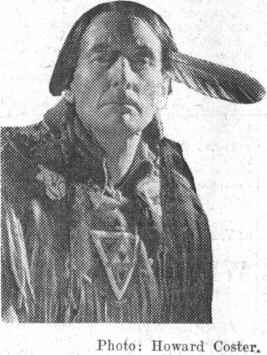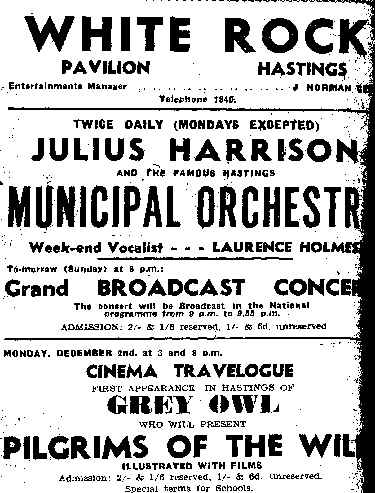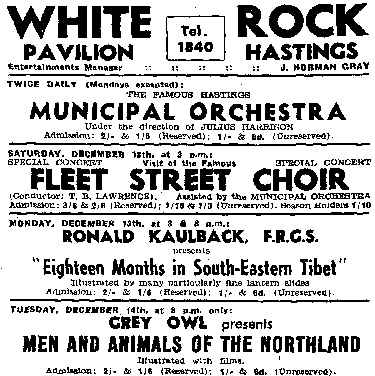
Grey Owl at the time he visited Hastings in 1935
Archie Grey Owl
Grey Owl is not forgotten in Hastings - click here
Hastings, with its air of tired gentility and fading facades, at first glance appears a very unlikely cradle for dreams, the aged muse for great thoughts, but it has provided inspiration for some of the most outstanding and progressive ideas of the 20th century. Hanging between land and sea, this microcosm of the world at large, can be all things to all men, to the wandering Spaniard it can become his Malaga, to the Frenchman his Montmartre, to the Italian his own Florence, the Sicilian, Palermo. But strangely its properties are only liminal, it is only a stepping stone, once the dream or idea has been set in practical foundations, Hastings somehow becomes too small for it and the great thought is taken, shared with the world at large, its birth place forgotten by all but a few.

Grey Owl at the time he visited Hastings in 1935
Many things contribute to the inspirational qualities of this extraordinary town, massive diversity of architectural style, sweeping vistas that pull the eye into the far distance, stunning geology, the thundering power of the sea, sometimes stormy, sometimes at peace. And surrounding the town some of the most varied countryside in the British Isles. To the East a series of rugged glens, each with its own tumbling stream hurrying to the sea. Each glen clothed in lush, tangled vegetation, scattered with boulders and punctuated by towering ivy-clad trees of great age. From Fairlight, the highest point above the glens can be seen the great golden crescent of sand that forms the beaches of Winchealsea and Rye Bay, then the land falls away in the most breathtaking fashion to meet the sea at Pett Levels. Flatlands, here teeming with all the life that marshland so fondly encourages, everything that swims, hops, wriggles and flies - fin, fur and feather all thriving on each other and the moist land around. On eastward again, the mile-wide gravel strands, weather hardened, summer-parched ground, home to plover, snake and tiny plants. North of Hastings behind the natural fortress wall of The Ridge is rolling farmland scattered with a multiplicity of woodlands harbouring small game of every sort. To the West the great Pevensey Marsh, once a vast lagoon which its time harboured the Rome’s Northern Fleet but long since drained. And beyond this the huge bulk of the rolling South Downland. On a clear day from North’s Seat, Hastings’ highest point, which provides stunning vistas in every direction, it is possible - looking West - to see the entire thirty miles that stretch past the Downland to the Lewes Gap.
Blacklands Church where Archibald Stansfield Belaney was
christened in 1888
No surprise then that great ideas can be born in such a place, that great minds have come here to refresh their thinking, Nor that on rarer occasion a great man or woman can be born and grow up under the many positive intellectual influences of the Town that in so many ways mirrors the history of the civilisation of humanity in the variety of its construction. From the architecture of the classical societies of the Mediterranean through to the symbols of the prosperity of the Industrial Revolution. But also it must not be forgotten that Hastings with its contrived artificiality also contrasts sharply with the natural world that surrounds it and vigorously demands attention. So in the town that gave birth to television, cradled moderate socialism, gave the world one of its first woman doctors and provided the backdrop to great artists, poets, great soldiers, sailors (and their ladies). Here also was born that most modern of ideas, environmental conservation, and the man - Archibald Stansfield Belaney, aka Grey Owl - who was to introduce the concept. This is the story of how the two became one.
Poor Archie Belaney, his mother was extremely young when married, some sources suggest as young as thirteen years. His father, George, was a scion of a good Scottish lowland family of that uniquely Scots breed that produces literary farmers of the Burns ilk and which already had well known published works to its name. His father was a wastrel of the "bounder and a cad" variety and very effectively disposed of the family fortune. Kittie, the child wife, was persuaded by sufficient financial encouragement to leave the care and education of Archie in the hands of his grandmother Julia and his maiden aunts Carrie and Ada. It must be kept in mind that these three ladies now lived in genteel poverty in Hastings as a result George’s excesses and it is to their credit that Archie was not made to suffer on his father’s account but was encouraged to develop in a very liberal fashion given the social attitudes of the period. Regardless of their gentle attentions Archie grew up as a fairly solitary character with only a few lasting friendships. His first and abiding interest was in the natural world and how it functioned. Many stories are told of his huge and changing menagerie of small creatures living and dead. Not only was his interest in animals for their own sake but he was also fascinated in their environments and particular modes of life, a sharp contrast to other collectors and naturalists of the time, the spike-it and stuff-it brigade . In fact he went to great pains to create natural, ideal accommodation for his small guests. This focus would in later life provide the foundation of his philosophy, a deep understanding of environment and its importance to the natural world, an overview of the mechanics and mechanisms of nature.
During the period of Archie’s formative years - he was born in September 1888 - there was growing interest in the native American and what remained of his lifestyle, the concept of the "noble savage" was undergoing a face lift. The Redman, now virtually extinct, his culture destroyed, was being reborn in legend as a brave, clever and resourceful adversary worthy of the military power that had been used to exterminate him. Archie was to become entranced by the tales of how the North American Indian shared his life with the forest and stream, supporting himself by his own deep understanding of his surroundings. So both interests merged and the growing boy spent more and more time roaming the wilder parts of the local countryside. Perfectly prepared to expose himself to all weather conditions in an effort to emulate the hardiness of the Canadian Indian, Archie often endangered his life by risking illness through exposure to the elements but this risk was small compared to those taken in his manufacture of gunpowder. The products of which were tried out in the silent sleeping streets of Hastings, to the massive chagrin of the local police.
Hastings Grammar School, Nelson Road, around the time
Archie Belaney was a pupil there how this fits into the townscape can be seen in the
aerial view of Queens Road In 1964 the
school moved to Parkstone Road
At School - he went to Hastings Grammar, leaving at 16 years - he was well remembered as a character but not easily reached. He was not thought to have been a brilliant pupil but did very well in Literature and Religious Studies, he was also remembered for his love of music. A master observed that he was not really tested at the things he was good at, wood-lore and animals, the latter appearing wherever Archie had lately been. His despairing Aunt Ada gave up on attempts to further his education and he went to work for Messrs Cheale, Timber Merchants of Ore on The Ridge at Hastings. He found the work extremely dull and frequently expressed the wish to go to Canada as a trapper. At first no attention was paid to his pleas, but he accelerated his departure to a new life by lowering an explosive device down the chimney of his employer’s office-workshop, partially destroying the building. After this forceful demonstration of displeasure his aunts had little choice but to yield to his wishes and at the age of 17 years the fledgling Grey Owl was winging his way to his Canadian Paradise. He would return to Hastings on four more occasions.
Hollington Church in the Wood where Archie
married Connie Holmes in 1916
During 1915 Archie joined the 13th Montreal Battalion of the Black Watch (dates and accounts vary) and soon entered service in France as a sniper, in January 1916 he was wounded in the wrist by a bullet and later that year on April 24th shot through the foot. As a sniper/observer he delayed his return from the field for treatment and gangrene affected the wound. The injury resisted treatment and cost him a toe. For more than a year he was moved about England from one military hospital to another as attempts were made to restore the damaged foot. During this time in Hastings he met again a childhood friend, Connie Holmes, courted her and married her at Hollington, Church-in-the-Wood. The marriage failed and he returned to Canada in September 1917. His foot was now permanently damaged and he was discharged from the army in Toronto, November 30th,1917 receiving a 20% disability pension.

Grey Owl appeared on the stage at the White Rock
Pavilion 2nd December 1935, ironically it is billed as "FIRST APPEARANCE IN
HASTINGS".

Grey Owl's second appearance in Hastings, December 14th
1937
In 1935 to further the sales of the Grey Owl books which Archie wrote, their publisher Lovat Dickson arranged a promotional lecture tour of the British Isles. Before this started Archie appeared on film and stated that he intended to carry out the tour dressed in the costume of the Canadian Indian to publicise the conservation issues so close to his heart. He visited Hastings on-tour on two occasions. On December 2nd, 1935, Archie appeared at the White Rock Pavilion to a packed house whose audience also contained his amused and somewhat bemused aunts. If they thought there was anything inappropriate about the Grey Owl persona, then they kept it to themselves. It is after his second visit to Hastings during the British tour of 1937 -December 14th, 1937 - that in response to pressure from the local press they admitted by letter to the Hastings Observer (23-30/4/1938) that they had every reason to believe that Grey Owl was their nephew Archibald Stansfield Belaney.
Archie had died of exhaustion April 13th, 1938, soon began the attempts to kill off Grey Owl as well. Only history will tell how successful these have or will be. My personal view if allowed one, is that both Archie and Grey Owl will live in memory long after their denigrators are forgotten and that those conservation issues that were raised by Archie Grey Owl will dominate our thinking for many generations to come. We should be grateful that they brought to our attention so speedily, with such emphasis, vigour and imagination.
(c) 1999 Bryn Fraser
Hastings
21st April 1999.
Grey Owl's Hastings today click here
Please sign our visitors book. We regret that we cannot undertake to answer your Grey Owl questions but other visitors may be able to help so please use a valid e-mail address.
Thanks are due to Betty Taylor for background, David
Padgham for the Grammar School picture, Richard Pollard for the two church pictures and
Ion Castro for the rest of the pictures and the page construction.
The Background midi is Beethoven's "Moonlight
Sonata" which, we are told, Archie learned to play when he was a child in
Hastings
View the even older visitors book
LINKS
National Library of Canada - Heroes
Grey Owl, the film etc.
Jack Humphrey's Photo Collection
XL(2000) Ltd. are sponsors of 1066.net. Hastings' favourite web site
020827 040118 050122 050228 081014 100110 151006